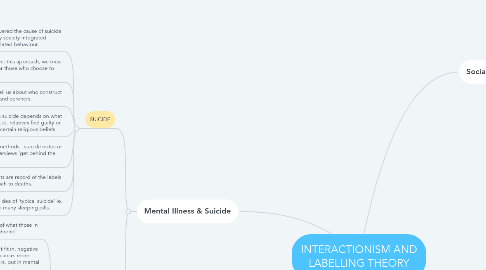
1. Mental Illness & Suicide
1.1. SUICIDE
1.1.1. Durkheim: discovered the cause of suicide in how effectively society integrated people and regulated behaviour.
1.1.2. Interactionists reject this approach, we must study meanings for those who choose to kill themselves.
1.1.3. Douglas: stats tell us about who construct them ie. police and coroners.
1.1.4. labelled as a suicide depends on what people think ie. relatives feel guilty or coroner has certain religious beliefs.
1.1.5. Use qualitative methods - suicide notes or unstructured interviews 'get behind the label'.
1.1.6. Atkinson: stats are record of the labels coroners attach to deaths.
1.1.7. coroners use idea of 'typical suicide' ie. hangings, too many sleeping pills.
1.2. MENTAL ILLNESS
1.2.1. Reject stats are record of what those in power label as 'schizophrenic'
1.2.2. Lemert: paranoia, doesn't fit in, negative response begins 2nd deviance. more exclusion, confirming fears. put in mental institution.
1.2.3. Rosenhan: 'pseudo-patient' researchers claimed to be hearing voices was diagnosed this became master status but when acting normal still treated.
1.2.4. Goffman: 'mortification of self' old identity killed and replaced by inmate. done by degradation rituals like no personal items.
1.2.5. Become institutionalised and unable to re-adjust to outside world.
1.2.6. Braginski: inmates manipulated symptoms to appear 'not well enogh' but not sick enough' so enables free movement.
2. Evaluation
2.1. Too deterministic, when labelled a deviant career isn't inevitable.
2.2. Realists: ignore real victims of crime.
2.3. Focus on less serious crimes.
2.4. Assumes offenders are passive victims & ignores fact that people have free will.
2.5. Fails to explain why people commit primary deviance in the first place.
3. Social Construction of Crime
3.1. Not the nature of the act but the nature of society's reaction to the act.
3.2. Becker: deviant is someone who the label has been successfully applied.
3.3. moral entrepreneurs: lead moral crusade to change the law.
3.4. Creates 'outsiders' or outlaws. Expansion of social control agency.
3.5. WHO GETS LABELLED
3.5.1. not everyone gets punished; depends on the interactions w agencies of social control, the person who committed the crime and situation of offence.
3.5.2. Palilvan and Briar: police decisions on who to arrest was based on looks.
3.5.3. Cicourel: typifications - stereotypes of what the typical criminal is like.
3.5.4. middle class criminal would be less likely to be charged as parents could negotiate.
3.5.5. Topic vs. source: stats don't give a valid picture must investigate the process taken to create them.
3.5.6. Social construction of crime stats: on;y tell us the activities of the police not the amount of crime in society.
3.5.7. Dark figure: difference between offical stats and real rate of crime (unreported)
3.5.8. Alt stats: victim surveys, self report studies but has drawbacks ie. people forget or exaggerate.
4. Effects of Labelling
4.1. PRIMARY AND SECONDARY DEVIANCE
4.1.1. Primary deviance refers to deviant acts that aren't publicly labelled, is a moment of madness. Secondary deviance is result of societal reaction.
4.1.2. Master status: being caught publicly shamed and shunned. Can only be seen as their label.
4.1.3. Crisis of self-concept, accept their label and lead to self-fulfilling prophecy and becoming label.
4.1.4. Deviant career: society's reaction reinforces 'outsider' status, makes it hard to go straight, join a subculture.
4.1.5. Young: drugs was primary deviance, till labelled by control culture, see themselves as outsiders, form subculture and attract more attention.
4.2. DEVIANCE AMPLIFICATION SPIRAL
4.2.1. Attempt to control leads to an increase in the level of deviance.
4.2.2. Cohen: press exaggeration of crime began moral panic. police began arresting more and imposing harsh penalties.
4.2.3. Demonising mods and rockers further marginalising them as outsiders.
4.2.4. folk devils vs. dark figure: over-labelled and over-exposed to public. draws resources away from detecting.
4.3. LABELLING & CRIMINAL JUSTICE POLICY
4.3.1. Increase in attempt to control has opposite effect.
4.3.2. Logical to make and enforce fewer rules for people to break eg. decriminalising soft drugs.
4.3.3. Avoid publicly 'naming and shaming', by excluding them from mainstream society pushes them into further deviance.
4.3.4. Braithwhaite: Disintegrative shaming, crime and criminal are labelled bad. Reintegrative shaming, labels the act not the actor.
4.3.5. This avoids stigmatising offender as evil, making them aware of their actions. separate offender from offence

